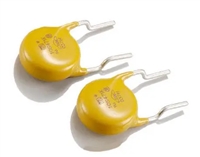MC13135 MC13136
CIRCUIT DESCRIPTION
The MC13135/13136 are complete dual conversion
Mixers
The first and second mixer are of similar design. Both are
receivers. They include two local oscillators, two mixers, a
limiting IF amplifier and detector, and an op amp. Both
provide a voltage buffered RSSI with 70 dB of usable range,
isolated tuning diode and buffered LO output for PLL
double balanced to suppress the LO and input frequencies to
give only the sum and difference frequencies out. This
configuration typically provides 40 to 60 dB of LO
suppression. New design techniques provide improved mixer
linearity and third order intercept without increased noise.
The gain on the output of the 1st mixer starts to roll off at
about 20 MHz, so this receiver could be used with a 21 MHz
first IF. It is designed for use with a ceramic filter, with an
output impedance of 330 Ω. A series resistor can be used to
raise the impedance for use with a crystal filter, which
typically has an input impedance of 4.0 kΩ. The second mixer
input impedance is approximately 4.0 kΩ; it requires an
external 360 Ω parallel resistor for use with a standard
ceramic filter.
operation, and a separate V
Improvements have been made in the temperature
performance of both the recovered audio and the RSSI.
pin for the first mixer and LO.
CC
V
CC
Two separate V
continue running while the rest of the circuit is powered down.
They also isolate the RF from the rest of the internal circuit.
lines enable the first LO and mixer to
CC
Local Oscillators
The local oscillators are grounded collector Colpitts, which
can be easily crystal–controlled or VCO controlled with the
on–board varactor and external PLL. The first LO transistor is
Limiting IF Amplifier and Detector
internally biased, but the emitter is pinned–out and I can be
Q
The limiter has approximately 110 dB of gain, which starts
rolling off at 2.0 MHz. Although not designed for wideband
operation, the bandwidth of the audio frequency amplifier has
been widened to 50 kHz, which gives less phase shift and
enables the receiver to run at higher data rates. However,
care should be taken not to exceed the bandwidth allowed by
local regulations.
increased for high frequency or VCO operation. The collector
is not pinned out, so for crystal operation, the LO is generally
limited to 3rd overtone crystal frequencies; typically around
60 MHz. For higher frequency operation, the LO can be
provided externally as shown in Figure 16.
Buffer
The MC13135 is designed for use with an LC quadrature
detector, and does not have sufficient drive to be used with a
ceramic discriminator. The MC13136 was designed to use a
ceramic discriminator, but can also be run with an LC quad
coil, as mentioned in the Test Circuit Information section. The
data shown in Figures 12 and 13 was taken using a muRata
CDB455C34 ceramic discriminator which has been specially
matched to the MC13136. Both the choice of discriminators
and the external matching circuit will affect the distortion and
recovered audio.
An amplifier on the 1st LO output converts the
single–ended LO output to a differential signal to drive the
mixer. Capacitive coupling between the LO and the amplifier
minimizes the effects of the change in oscillator current on
the mixer. Buffered LO output is pinned–out at Pin 3 for use
with a PLL, with a typical output voltage of 320 mV at V
pp
CC
= 4.0 V and with a 5.1 k resistor from Pin 3 to ground. As seen
in Figure 14, the buffered LO output varies with the supply
voltage and a smaller external resistor may be needed for low
voltage operation. The LO buffer operates up to 60 MHz,
typically. Above 60 MHz, the output at Pin 3 rolls off at
approximately 6.0 dB per octave. Since most PLLs require
RSSI/Op Amp
The Received Signal Strength Indicator (RSSI) on the
MC13135/13136 has about 70 dB of range. The resistor
needed to translate the RSSI current to a voltage output has
been included on the internal circuit, which gives it a tighter
tolerance. A temperature compensated reference current
also improves the RSSI accuracy over temperature. On the
MC13136, the op amp on board is connected to the output to
provide a voltage buffered RSSI. On the MC13135, the op
amp is not connected internally and can be used for the RSSI
or as a data slicer (see Figure 17c).
about 200 mV drive, an external amplifier may be required.
pp
Figure 14. Buffered LO Output Voltage
versus Supply Voltage
600
R
= 3.0 k
Ω
500
400
300
200
100
Pin3
R
= 5.1 kΩ
Pin3
2.5
3.0
3.5
4.0
4.5
5.0
5.5
V
, SUPPLY VOLTAGE (Vdc)
CC
6
MOTOROLA ANALOG IC DEVICE DATA






 PCF8574资料解读:主要参数分析、引脚说明
PCF8574资料解读:主要参数分析、引脚说明

 AD637数据手册解读:主要特性、引脚及其功能解读、电气参数
AD637数据手册解读:主要特性、引脚及其功能解读、电气参数

 ADUM1201资料手册解读:参数分析、引脚说明、应用分析
ADUM1201资料手册解读:参数分析、引脚说明、应用分析

 一文带你了解压敏电阻器在直流电路中的过压保护作用
一文带你了解压敏电阻器在直流电路中的过压保护作用
